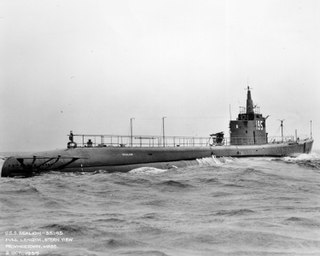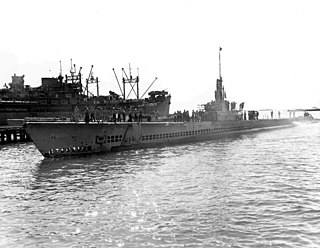Two submarines of the United States Navy have been named USS Sealion for the sea lion, any of several large, eared seals native to the Pacific.

The United States Navy (USN) is the naval warfare service branch of the United States Armed Forces and one of the seven uniformed services of the United States. It is the largest and most capable navy in the world and it has been estimated that in terms of tonnage of its active battle fleet alone, it is larger than the next 13 navies combined, which includes 11 U.S. allies or partner nations. with the highest combined battle fleet tonnage and the world's largest aircraft carrier fleet, with eleven in service, and two new carriers under construction. With 319,421 personnel on active duty and 99,616 in the Ready Reserve, the Navy is the third largest of the service branches. It has 282 deployable combat vessels and more than 3,700 operational aircraft as of March 2018, making it the second-largest air force in the world, after the United States Air Force.

Sea lions are sea mammals characterized by external ear flaps, long foreflippers, the ability to walk on all fours, short, thick hair, and a big chest and belly. Together with the fur seals, they comprise the family Otariidae, eared seals, which contains six extant and one extinct species in five genera. Their range extends from the subarctic to tropical waters of the global ocean in both the Northern and Southern Hemispheres, with the notable exception of the northern Atlantic Ocean. They have an average lifespan of 20–30 years. A male California sea lion weighs on average about 300 kg (660 lb) and is about 8 ft (2.4 m) long, while the female sea lion weighs 100 kg (220 lb) and is 6 ft (1.8 m) long. The largest sea lion is Steller's sea lion, which can weigh 1,000 kg (2,200 lb) and grow to a length of 10 ft (3.0 m). Sea lions consume large quantities of food at a time and are known to eat about 5–8% of their body weight at a single feeding. Sea lions can go around 16 knots in water and at their fastest they can go up to 30 knots. Three species, the Australian sea lion, the Galápagos sea lion and the New Zealand sea lion are listed as Endangered.

Pinnipeds, commonly known as seals, are a widely distributed and diverse clade of carnivorous, fin-footed, semiaquatic marine mammals. They comprise the extant families Odobenidae, Otariidae, and Phocidae. There are 33 extant species of pinnipeds, and more than 50 extinct species have been described from fossils. While seals were historically thought to have descended from two ancestral lines, molecular evidence supports them as a monophyletic lineage. Pinnipeds belong to the order Carnivora and their closest living relatives are believed to be bears and the superfamily of musteloids, having diverged about 50 million years ago.
- USS Sealion (SS-195), a Sargo-class submarine was wrecked and scuttled in the first days of World War II.
- USS Sealion (SS-315), a Balao-class submarine, served with distinction from the second half of World War II through first half of the Cold War.

USS Sealion (SS-195), a Sargo-class submarine, was the first ship of the United States Navy to be named for the sea lion, any of several large, eared seals native to the Pacific.
The Sargo-class submarines were among the first US submarines to be sent into action after the Japanese attack on Pearl Harbor, starting war patrols the day after the attack, having been deployed to the Philippines in late 1941. Similar to the previous Salmon class, they were built between 1937 and 1939. With a top speed of 21 knots, a range of 11,000 nautical miles (20,000 km), and a reliable propulsion plant, along with the Salmons they were an important step in the development of a true fleet submarine. In some references, the Salmons and Sargos are called the "New S Class", 1st and 2nd Groups.

World War II, also known as the Second World War, was a global war that lasted from 1939 to 1945. The vast majority of the world's countries—including all the great powers—eventually formed two opposing military alliances: the Allies and the Axis. A state of total war emerged, directly involving more than 100 million people from over 30 countries. The major participants threw their entire economic, industrial, and scientific capabilities behind the war effort, blurring the distinction between civilian and military resources. World War II was the deadliest conflict in human history, marked by 50 to 85 million fatalities, most of whom were civilians in the Soviet Union and China. It included massacres, the genocide of the Holocaust, strategic bombing, premeditated death from starvation and disease, and the only use of nuclear weapons in war.
| This article includes a list of ships with the same or similar names. If an internal link for a specific ship led you here, you may wish to change the link to point directly to the intended ship article, if one exists. |









